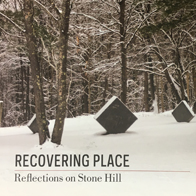Elizabeth Kolbert is a staff writer for The New Yorker. Her most recent book, The Sixth Extinction, received the Pulitzer Prize for general nonfiction in 2015. She is a two-time National Magazine Award winner and has received a Heinz Award and Guggenheim Fellowship. Kolbert is a visiting fellow at the Center for Environmental Studies at Williams College. She lives in Williamstown, Massachusetts.

July 4–October 10, 2016
soil monoliths
Soil monoliths
Collected on Stone Hill, 2015
TRANSCRIPT:
Over the last ten thousand years, Stone Hill has assumed many forms: lake bottom, forest, woodlots, and farms. Each of these identities is preserved in its soil—a history recorded in rot. Visitors usually encounter only the last few pages of this story; the early chapters remain hidden from view. Like the papyri of Pompeii, they’ve sat unread for millennia.
Soil is almost infinite in its variety. Its composition changes from woodland to meadow, from bog to bluff, even from one square foot to the next. Scientists have developed a handy mnemonic for the forces that affect soil’s makeup: climate, organisms, relief (topography), parent material (the composition of the underlying rock), and time. These can be remembered as CLORPT.
The four soil cores displayed here were taken from different spots on Stone Hill and show that location really does matter. The first comes from a patch of eastern Hemlock forest. In this spot the rain of needles makes the soil so acidic that decomposition is slowed. The result is a deep layer of organic matter. The second comes from a stretch of deciduous forest that was used as a woodlot; here the soil is less acid and the organic layer correspondingly thinner. The third core was taken from a hay meadow that doubled as a pasture. The last core comes from a corn field that has been plowed and replowed many times. The action of the plows has raised that which was long buried, scrambling the chronology of the story.
The future of Stone Hill will also be inscribed in its soil. Climate change, for example, will bring new vegetation. But eventually even this record of rot will be erased. Perhaps another glaciation will scour the hillside, or perhaps, in an ice-free world, the forces of erosion will wash it out to sea.
Recovering Place: Reflecting on Stone Hill
By Mark C. Taylor
An illustrated book chronicling the land art and sculptures created by Mark C. Taylor at his home in the Berkshire hills, echoing themes found in the exhibition. Supported in part by Herbert A. Allen, Jr. and the Clark Art Institute and published by Columbia University Press. Call the Museum Store at 413 458 0520 to order.


